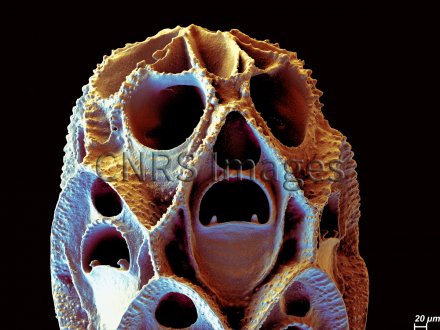Production year
2019

© Stephan BORENSZTAJN / Caroline THALER / IPGP / CNRS Images
20210137_0003
Bryozoans are reef-building multicellular organisms less than a millimetre in size that have calcium carbonate skeletons. These tiny animals, which live in colonies at all latitudes, play a major role in regulating the climate by storing the CO2 dissolved in seawater in their mineral structure. This is the tip of the skeleton of a colony of bryozoans of the species Cellaria fistulosa. Each organism lives in a sort of calcium carbonate chamber with openings, the main one of which enables the animal to filter seawater and feed. Around a dozen such cavities are visible: those at the top are still in the process of being made. This surprising shape is the random result of the gradual growth of the colony. Researchers are trying to gain a better insight into the ability of bryozoans to resist environmental disturbances in a context of ocean acidification. This image is a winner of the 2021 La preuve par l'image (LPPI) competition.
The use of media visible on the CNRS Images Platform can be granted on request. Any reproduction or representation is forbidden without prior authorization from CNRS Images (except for resources under Creative Commons license).
No modification of an image may be made without the prior consent of CNRS Images.
No use of an image for advertising purposes or distribution to a third party may be made without the prior agreement of CNRS Images.
For more information, please consult our general conditions
2019
Our work is guided by the way scientists question the world around them and we translate their research into images to help people to understand the world better and to awaken their curiosity and wonderment.